What is Binary MLM Plan?
The Binary MLM compensation plan is a well-known network marketing plan. And, in general, the jury is evenly split on how the MLM binary plan is received. Some distributors are enthusiastic about the plan’s distinctive rules and techniques, while others may prefer more flexibility. In a binary scheme vs pyramid scheme comparison, a binary plan can have a legitimate product or service, while pyramid schemes rely solely on recruitment to generate income.
Still, along with the matrix plan and unilevel plan, it is one of the three basic compensation plans and has helped a lot of businesses succeed. Continue reading to learn more about the MLM binary plan and the benefits and drawbacks of implementing it in your business.
Click to check out the full Binary MLM Plan guide — perfect for offline reading.
Infinite MLM Software: Empowering Binary MLM Plan
Infinite MLM software is a leading MLM software company in India that offers exceptional software applications to manage binary MLM plan. As one of the top binary MLM software companies, it furnishes robust binary MLM software that streamlines the process of managing binary compensation plans. With its exceptional features like real-time reporting and advanced genealogy, binary plan of Infinite MLM Software is an ideal choice for businesses looking to scale up their network marketing efforts.
Start building your wealth with our binary MLM plan. Don’t miss out on this incredible opportunity!
Structure of Binary MLM Plan
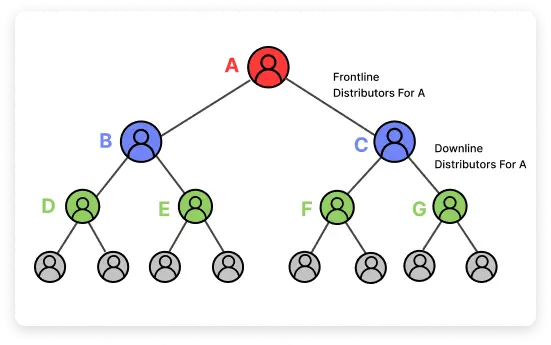
A MLM binary plan is relatively easy and convenient when compared to other MLM plans. A member’s front line is limited to two downlines in a binary MLM, but the depth is limitless. This implies that in order to start earning, each member just needs to recruit two “front line” representatives in a binary MLM. Spillover occurs when a member recruits more than two individuals. The spillover members are arranged in levels below the front-line members. A two-leg downline of two-by-two levels is developed as distributors are recruited and the binary MLM structure fills in. The amount of levels that can be included in a MLM binary plan is unlimited.
Working of Binary MLM Plan
Binary MLM compensation plans are straightforward to understand, making it much easier to recruit new members to the network. Instead of a percentage of sales for multiple levels of representatives, they are compensated based on the sales volume generated in each of the legs. Only the “pay leg,” which is the lower-earning leg, is used to calculate MLM commissions in the MLM binary plan formula. The other leg which generates more income is called the “reference leg”.
Distributors of binary MLM networks have an incentive to build out both legs and operate as a team across the two legs to optimize income because income and commissions are based on the lower-earning leg in MLM binary plan. Members can get the most out of their whole downline when sales are more evenly distributed between the two legs. Sponsors would have no motivation to focus on the lower-earning leg if commissions were decided based on the higher-earning leg, causing sales and recruiting to stagnate eventually.
The binary MLM plan allows MLM companies to better monitor their growth while also estimating commissions and incentives more precisely. Typically, MLM businesses would set a commission cap for each level of distributor earnings in the pay leg by defining a set commission percentage.
Would you like to automate your MLM business by adopting a binary MLM plan? Go ahead with our Binary MLM software to automate the MLM binary plan.The placement of spillover will be determined by the MLM company, which means that the preferences for spillover will vary depending on the company. These are the different types of spillovers in the Binary MLM Plan.
Pros of the Binary MLM Plan
- Opportunity to maximize sales productivity.
- Enables members to recruit new representatives and strategically balance spillover.
- Potential for rapid growth.
- Easy for new recruits to understand the commission structure, get engaged, and start earning.
- Representatives benefit as new representatives come on board.
- Inspires teamwork.
Cons of the Binary MLM Plan
- Profit margin depends solely on the downline team remaining active.
- Keeping the legs balanced and high-producing can sometimes be a challenge.
- If the gap between legs is allowed to get too wide, recruiting could become difficult.
Would you like to automate your MLM business by adopting a binary MLM plan? Go ahead with our Binary MLM software to automate the binary MLM compensation.
Different Scenarios in MLM Binary Plan
Before we have a look at the different scenarios in MLM binary plan, there are some terms you need to know. The sponsor is the distributor who introduces the new member to the binary MLM network. The parent is the distributor, who is the direct upline of the new member in the binary MLM plan.
Guidelines for Spillover
Spillover can be done in many ways as per the preference of the company, but generally spillover has a framework when admitting new recruitment to the genealogy tree.
Normally by default new recruitment spilled over are placed at extreme left and the next spilled over joinee is placed to the extreme right. Then further spilled over joinees are placed in the extreme left again and then to the extreme right, and this sequence goes on by filling positions in the extremes left and right positions of the genealogy tree. As per the sponsor preference or the owner privilege, the new members can be added to any available position in the MLM binary plan.
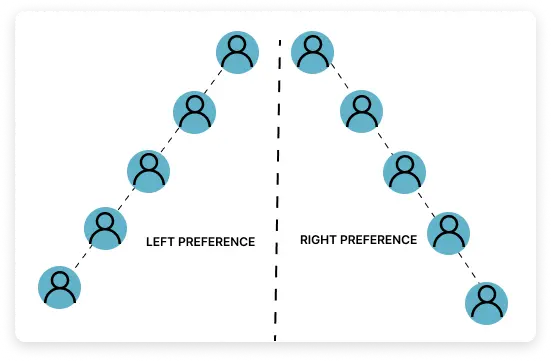
Listed below are a few of the scenarios that can happen when sponsors place new recruitment at different positions in the genealogy tree of a binary MLM plan.
-
The Sponsor & the Parent of downlines are the same
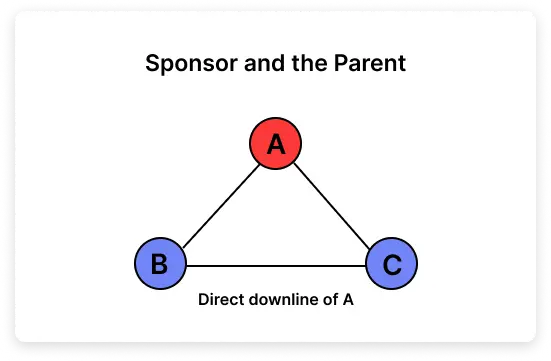
If a distributor X sponsors A and If A introduces a new member B to the left leg of A in the binary tree, then B is the direct downline of A. If again A sponsors a new member C, then it is added to the right of A since it was the vacant position.
Now B, C are the direct downlines of A. A is the sponsor as well as the parent of B, C.
-
The Sponsor and the Parent of the downline are different
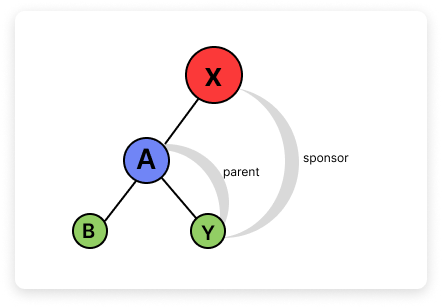
Here X sponsors A and Y, where Y is placed under the right leg of A. A sponsors new member B, and B is placed under the left leg of A, since there is no vacant position at the left leg.
Now For Y, A is the parent and X is the sponsor. Here the sponsor and the parent are different for the Y. The binary of A is formed from their own effort and the upline’s (X) effort by spilling over the member Y.
-
Spillover without completely forming the binary
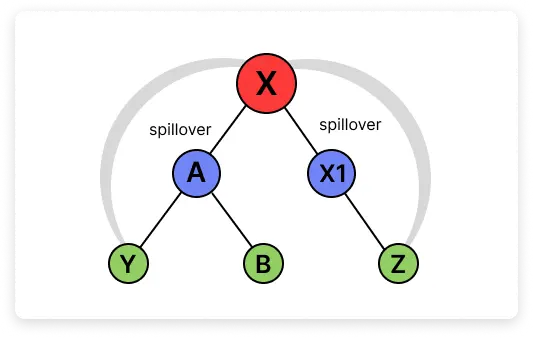
Distributor X introduces or sponsors two new members A, X1 to the right, and the left leg of binary structure and binary of X is formed.
Now A sponsors new member B to the right leg as the left position of A is filled by the new member Y, who is sponsored again by X. X also sponsors Z and places to the right of X1. Here Y, Z is spillover and placed under the downlines of X, A and X1. Y is placed under the left downline of X , A and Z is placed under the right downline of X, X1.
Two spillovers occur on two sides of X without completely forming the binary on either side.
-
Sponsoring only to the left leg of the binary structure
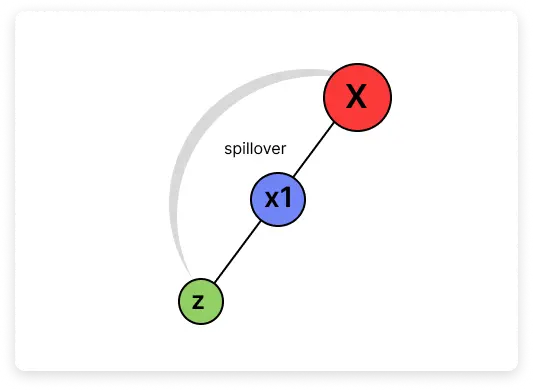
In this scenario, A introduces two new members B and C. B is placed under the direct left leg position of A, and C is placed to the direct left leg position of B. Here C is the spillover which is placed to the extreme left.
-
Normal spillover in binary structure
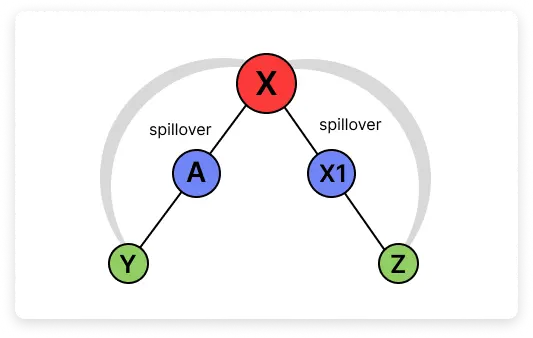
When the left and the right leg of any member is filled, the next new member sponsored will be placed under the next level as spillover. This is called normal spillover.
When the distributor X sponsors new members A and X1, the binary structure of X is completed, and if X again sponsors the new members Y and Z, they will be placed under the next level as normal spillovers.
Download our free Binary Plan software now and start achieving your goals.
Types of Spillovers in the Binary MLM Plan
When the binary MLM structure is formed for a distributor by introducing two new members to the right and the left leg of a MLM binary plan, the next new members sponsored by the same distributor will be spilled over to the next available position.
The placement of spillover will be determined by the MLM company, which means that the preferences for spillover will vary depending on the company. These are the different types of spillovers in the Binary MLM Plan.
-
Extreme End Spilling
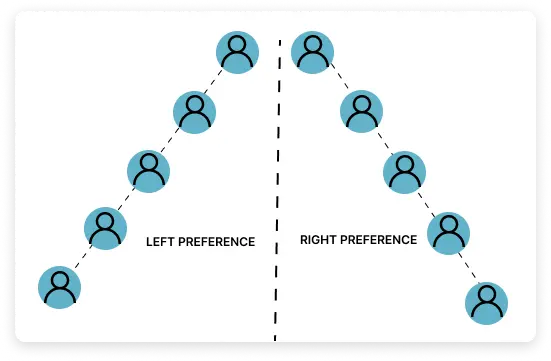
The spilling preference can be set to the extreme right or extreme left leg of the MLM binary plan structure. This type of spill is preferred by most of the MLM companies to make the distributors more engaged in the sales process since they need to balance their pair with sales volume to get the binary MLM commission. Overall it enhances teamwork and boosts sales volume.
-
Weaker Leg Spilling
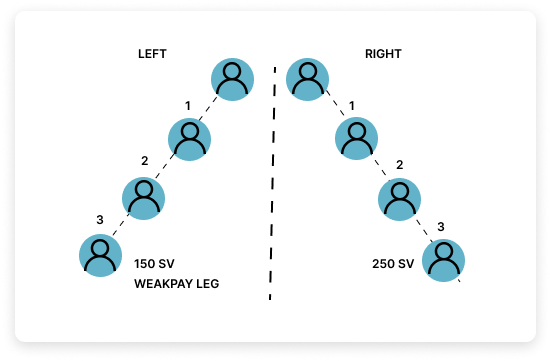
Here the newly introduced members are placed under the weak leg of the MLM binary plan structure. The weak leg may be the left or the right leg depending upon the lowest sales volume acquired. This is done with the aim that the new member will be able to increase sales volume on the weaker leg.
-
Balanced Ratio Spilling
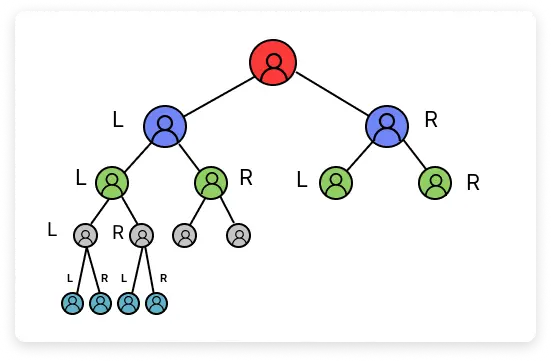
In this spilling, new members are evenly distributed between the two legs to maintain balance, prevent dominance, and ensure fair commission and bonus distribution. This strategy can result in a more sustainable and successful MLM business.
-
Multi-Position Spilling
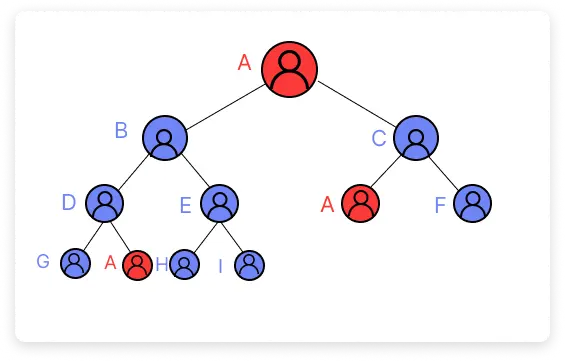
The distributor may be offered multiple positions in the binary MLM structure depending upon the joining package acquired. When the first three positions in the MLM binary plan structure get filled, the next immediate positions are filled by the spillover. This type of spillover preference is offered depending upon the joining package of top binary MLM companies.
Binary MLM Calculator
Binary MLM calculator helps network marketers to analyze their business performance and make informed decisions based on the generated reports in a MLM binary plan software.
MLM binary plan calculator is an essential tool for MLM businesses that follow a binary plan. With features like binary MLM plan calculator, Infinite MLM software simplifies complex calculations, making it easy for distributors to focus on growing their business.
With our Binary MLM Calculator, your earnings will surely fly high. Give it a try!
Binary MLM Plan Commission Calculation
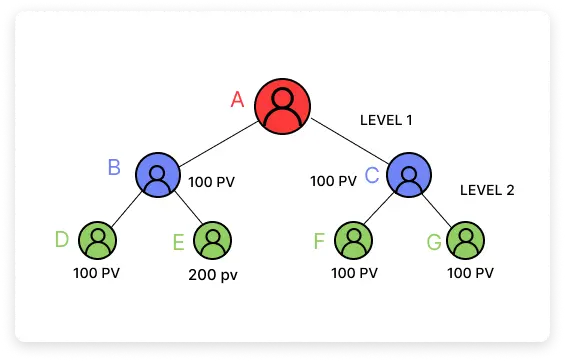
Here, we are calculating the commissions earned by A, B, C and D in this binary MLM. All the calculations done here are based on 10% P.V.
All the calculations done here are based on 10% P.V.
First, let’s calculate binary MLM commissions received by A.
In this network, A recruits B and C (B = 100 PV and C = 100 PV ). Since the volume of sales on both legs are equal and they are matched,
- Commission with respect to A
Commission earned by A = 10% of 100 = 10 USD.
In case the commission earned on both legs is not matched, then we will consider the leg with the lowest P.V, called the weaker leg, for calculations.
Now, B recruits D and E.
With respect to A , D and E will fall on its left.
D manages a P.V of 100 while E manages 200 P.V.
So the total PV on the left = 100+200 = 300 P.V.
On the right, C recruits F and G and F and G manages a P.V of 100 each
So, the total PV on the right of A = 100+100 = 200.
Going by the matching on the basis of weaker leg, the right leg is the weaker leg since it could raise only 200 PV in comparison with 300 PV on the left side.
Hence, 200 PV from the right leg of A is matched with 200 PV from the left leg and the remaining 100 PV from the left will be carried forward on the left side of A.
Therefore, the commission earned by A from B and C = 10% of 200 = 20 USD.
Therefore, the total commission earned by A = 10+20 = 30 USD.
-
Commission with respect to B
B recruits D on the left and E on the right.
D earns 100 PV while E earns 200 P.V.
Since the left leg is the weaker leg , 100 PV from the left and right is matched. The remaining 100 PV from the right is carried forward to the right leg of B.
Commission earned by B = 10% of 100 = 10 USD
Therefore, the total commission earned by B = 10 USD.
-
Commission with respect to C
C recruits F on the left leg and G on the right leg . Both F and G generate 100 PV each.
For C, since P.V on both the legs are equal, 100 PV on the left leg is matched with 100 P.V on the right leg and there is no carry forward in this case.
Commission earned by C = 10% of 100 = 10 USD.
Therefore, the total commission earned by C = 10 USD.
What is Binary Capping?
Binary Capping is an amount set by binary MLM Companies to maintain financial stability. The turnover of the company may be affected if the commission payout goes out of control. Binary Capping will depend upon binary MLM commission or sales volume.
Types of Binary Capping
-
Binary Capping Based On Sales Volume
This value is set based on the sales volume gained by the distributors in contrast with the joining package.
If distributor X achieves sales volume from the left leg as 200, the right leg as 400, and the binary capping is set to 100 SV, then the binary MLM commission will be provided only for the capping value of 100. The remaining 100 from the weak leg and 200 from the strong leg will be excluded and will not be taken for the next MLM binary plan commission cycle.
The company may prefer to set this capping daily, or weekly, or monthly.
-
Binary Capping Based On Commission
This value is set based on the MLM binary plan commission received by the distributors in contrast with the joining package.
Suppose distributor A joins with a joining package of $1000, the company may set the capping value to $5000 and the distributor will not receive more than $5000 as commission. This capping value can also be set daily, or weekly, or monthly.
Bonuses in the Binary MLM Plan
-
Matching Bonus
This bonus is paid out to distributors when someone they have personally sponsored earns a commission. The distributor also receives a percentage of the commission earned by their sponsored team members.
-
Custom Bonus
This is a bonus that can be tailored to the specific needs of a particular MLM company or distributor. It can be used to reward high-performing team members or incentivize specific behaviors.
-
Return Of Investment
This bonus is intended to reward distributors who make a specific financial commitment to their enterprise. A distributor might get a bonus, for instance, if they spend a certain sum of money on marketing supplies or product inventory.
-
Binary Commission Bonus
This bonus is paid out based on the sales volume generated in both legs of the binary tree. Many MLM binary plan software include automatic commission calculation based on their plan formula.
-
Leveling Bonus
Also known as the Depth Bonus, this bonus rewards distributors for reaching a certain level of depth in their binary tree. For example, a distributor might earn a bonus when they have 10 levels of distributors on their team.
-
Fast Start Bonus
This bonus is paid out when a new distributor joins the MLM company and makes their first purchase or sale. It’s designed to incentivize new distributors to get started quickly and build momentum.
-
Rank Advancement Bonus
MLM companies often have different ranks for their distributors, and reaching a higher rank can come with additional bonuses and benefits. The rank advancement bonus rewards distributors who reach a new rank within the binary tree structure.
Supercharge your MLM business with binary compensation plan and reach new heights of success. Click now to discover how.
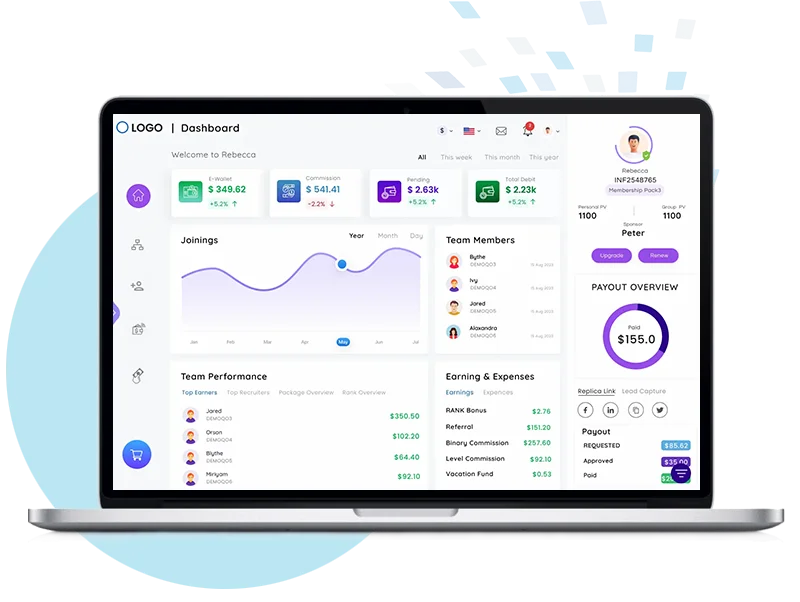 Enterprise Grade MLM Software, Powered by AI.
Enterprise Grade MLM Software, Powered by AI. MLM Software Demo with
MLM Software Demo withManage 1 Million Users
Binary Matching Bonus
Ceiling / Capping Settings
Spillover Binary Settings
 Recruit, Reward, Retain: The Best MLM Plans for Success
Recruit, Reward, Retain: The Best MLM Plans for Success Get in Touch With Our Experts
Get in Touch With Our ExpertsEnglish

















 Infinite MLM Software
Infinite MLM Software